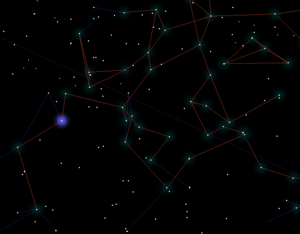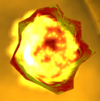Wormhole: Difference between revisions
m (Added Template:Revision tag.) |
(Added more information about polarity.) |
||
| Line 19: | Line 19: | ||
|} | |} | ||
=Polarity= | ==Wormhole Pairs== | ||
All wormholes exist in pairs, either between two solar systems or two galaxies. The wormholes always point towards their other pair through the host body. | |||
===Polarity=== | |||
When interstellar wormholes are formed the initiating wormhole will have a positive polarity, the destination wormhole will have a negative polarity. | |||
Traveling through a wormhole with a positive polarity requires a [[Wormhole_Drive|wormhole P drive]] or better, a negative polarity requires a wormhole PN drive or better. | |||
Intergalactic wormholes are always neutral. | |||
Traveling through a wormhole with a neutral polarity requires a wormhole PNN drive. | |||
The polarity of a wormhole can be identified by its color: | |||
* '''Positive''' wormholes are identified by blue, cyan and white colors. | * '''Positive''' wormholes are identified by blue, cyan and white colors. | ||
* '''Negative''' wormholes are identified by red, yellow and white colors. | * '''Negative''' wormholes are identified by red, yellow and white colors. | ||
* '''Neutral''' wormholes are identified by blue and magenta colors. | * '''Neutral''' wormholes are identified by blue and magenta colors. | ||
=Wormhole Types= | ==Wormhole Types== | ||
There are three types of wormholes: | There are three types of wormholes: | ||
* Natural '''interstellar''' wormholes that are present around a [[Solar_System|solar system]]'s primary sun. | * Natural '''interstellar''' wormholes that are present around a [[Solar_System|solar system]]'s primary sun. | ||
Revision as of 15:05, 9 September 2018
| This section is in need of revision. Please help improve it or discuss these issues on the talk page. The reason given is: Pages feels weirdly structured. Need more headlines to and more filling sections. |

Interstellar wormholes interconnect solar systems in a loose branching network. Almost every solar system has one or more interstellar wormholes near the primary sun. Not all solar systems are interconnected by wormholes. Wormholes create disjoint islands of interconnected solar systems.
Intergalactic wormholes interconnect galaxies in a loose branching network. Every galaxy has one or more intergalactic wormholes around the supermassive black hole at their core. All galaxies are interconnected by wormholes. There are two disjoint islands of galaxies in the intergalactic wormhole network; they form the regions of pvp-play and non-pvp play in the Shores of Hazeron Universe.
Starships use wormhole drives to travel instantly from one solar system to another through interstellar wormholes. Starships also use wormhole drives to travel instantly from one galaxy to another through intergalactic wormholes.
Star gates create a temporary wormhole to a destination solar system from which a preon was harvested. The destination system of a star gate could even be another galaxy, this of course require that the preon is from a star in that galaxy.
 |
 |
 |
 |
 |
Wormhole Pairs
All wormholes exist in pairs, either between two solar systems or two galaxies. The wormholes always point towards their other pair through the host body.
Polarity
When interstellar wormholes are formed the initiating wormhole will have a positive polarity, the destination wormhole will have a negative polarity. Traveling through a wormhole with a positive polarity requires a wormhole P drive or better, a negative polarity requires a wormhole PN drive or better.
Intergalactic wormholes are always neutral. Traveling through a wormhole with a neutral polarity requires a wormhole PNN drive.
The polarity of a wormhole can be identified by its color:
- Positive wormholes are identified by blue, cyan and white colors.
- Negative wormholes are identified by red, yellow and white colors.
- Neutral wormholes are identified by blue and magenta colors.
Wormhole Types
There are three types of wormholes:
- Natural interstellar wormholes that are present around a solar system's primary sun.
- Natural intergalactic wormholes that are present around the supermassive black hole.
- Temporary artificial wormholes are created by a star gate.